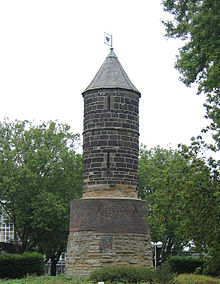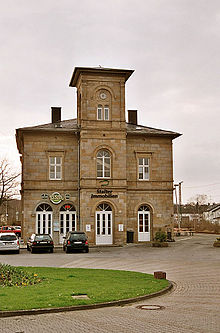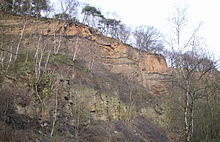Ruhr sandstone


A sandstone occurring along the Ruhr in North Rhine-Westphalia , Germany , which is used as a building material in a variety of ways, is called Ruhr sandstone .
Emergence
The Ruhr sandstone emerged from river sediments around 320 million years ago in the so-called Namur C , a period of the Upper Carboniferous . During the movements of the earth's crust, the layers of carbon were folded and compressed ( Variscan fold ). These movements resulted in fissures in the rock (cracks perpendicular to the direction of strike of the banks).
properties
In contrast to most other sandstones extracted in Central Europe , the Ruhr sandstone is characterized by low water absorption, very high compressive strength, abrasion resistance and weathering resistance. It is intensely pebbly cemented and strengthened by grain binding . In Germany, the Ruhr sandstone is one of the most resistant sandstones of all.
It has both gray and yellowish, reddish and brownish tones. The tinting occurs in particular through oxidation processes ( iron hydroxide , limonite ). The shiny particles in the Ruhr sandstone mostly come from muscovite mica. Some layers also contain tubers of iron ore . Occasionally one finds fossils of plants ( shed trees , ferns and so on) as floating debris in the Ruhr sandstone . Charcoal flakes can appear on layered surfaces ; coal seams are temporarily stored in some sandstone banks .
- Stone surfaces from Ruhr sandstone (gray pattern)
use


Ruhr sandstone was historically used for many sacred and profane buildings, especially in the Ruhr area and in the Bergisch-Mark region. It is used for masonry, stairs, flooring, window and door frames and wall coverings. In interior construction, Ruhr sandstone is also used for kitchen countertops and washstands, chimneys and chimney covers. It is one of the most wear-resistant sandstones in Germany and is one of the few sandstones that can be polished (experts refer to this as partially polished).
Occurrence
Near-surface rock occurrences of the Ruhr sandstone are generally located north of the Ruhr in the Ardey Mountains near Dortmund and west of it on both sides of the Ruhr valley as far as Mülheim . In the narrower sense, geologists only refer to the sandstone of the "(lower and upper) Sprockhövel layers" as Ruhr sandstone.
Quarries
In the past centuries there have been hundreds of large and small Ruhr sandstone quarries in the region. The farmers operated their own small quarries in the forest. It was different with the large quarry contractors, who also acted as building contractors.
Meanwhile, Ruhrstandstein is only quarried in four quarries (from east to west):
- Operation Oberste, Buchholz (coordinates: 51 ° 26 ′ 3.4 ″ N , 7 ° 30 ′ 21.9 ″ E )
- Operation Grandi , Herdecke
- Quarry and sawmill operation Lange eK (formerly Bossert operation), Sprockhövel (coordinates: 51 ° 19 ′ 33.6 ″ N , 7 ° 15 ′ 21.7 ″ E )
- Rauen plant , Mülheim-Broich
Decommissioned quarries (selection)
| business | designation | Place / location |
|---|---|---|
| Opherd thickness | Opherd thickness | Holzwickede |
| Ebberg | Ebberg | Swords |
| Imberg | Universitätsstrasse | Bochum |
| Imberg | Syburg | Dortmund |
| neck | Herdecke | |
| Bosselmann | Sirrenberg | Sprockhövel |
| Nippus | Sirrenberg | Sprockhövel |
| bird | Sirrenberg | Sprockhövel |
| Kopperschläger | Hammertal | Witten |
| Wigmann | Hammertal | Witten |
| Blankenagel | Hammertal | Witten |
| Rough | Coal sieves | Witten-Gedern |
| Bandman | Witten-Vormholz | |
| Külpmann | Albringhausen | Weather Albringhausen |
| Külpmann | Altenhain | Weather Albringhausen |
| Külpmann | Altenhain | Weather Albringhausen |
| Külpmann | Hödey | Wetter-Vosshöfen |
| Külpmann | At the Ostholz | Weather-Volmarstein |
See also
literature
- Olaf Otto Dillmann: The Ruhr sandstone. In: natural stone. 12/1998. 53rd Jg., Ulm, ISSN 0028-1026 , pp. 62-67.
- Olaf Otto Dillmann: Occurrence and extraction of natural stone on the northern edge of the Sauerland (excursion F on March 27, 2008). Jber. Middle Upper Rhine. geol. Ver., NF 90, Stuttgart 2008, pp. 255-265 (10 figs.).
Web links
- The Ruhr sandstone (with technical data and list of still active quarries)
- The genesis of the Ruhr sandstone
- Overview photo of a quarry in Wetter-Albringhausen



